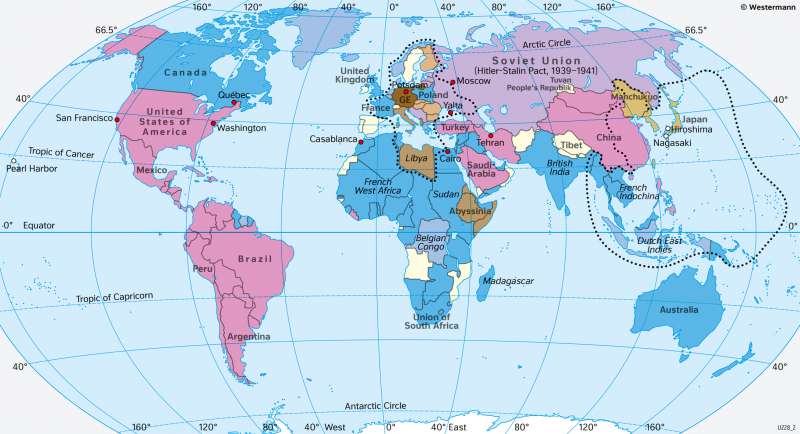The World - World War Two 1939–1945 (alliances)
Alliances since World War Two
978-3-14-100890-6 | Page 32 | Ill. 1

Overview
When the German Reich triggered the Second World War with its invasion of Poland (1 September 1939) and undertook its campaigns in Poland, Denmark, Norway, the Benelux countries, and France (1939/40), it did not yet have any allies.
The Axis powers and their allies
It was not until 27 September 1940 that an alliance treaty was signed in Berlin between Germany, Italy and Japan (Axis powers). Italy had occupied Albania in 1939 and entered the war in July 1940 with declarations of war against France and Great Britain. Acts of war had begun in Africa in the summer of 1940.
Japan had held alliance negotiations with Germany in 1939, but these were not resumed until the summer of 1940 under a new government. Japan had occupied large parts of China between 1937 and 1940, starting from Korea, and had installed a pro-Japanese-friendly government there. However, they had not been able to win the war. The Axis powers wanted to establish a European sphere of power (controlled by Germany and Italy) and an Asia-Pacific sphere of power (under Japanese control).
Hungary, Romania and Slovakia joined the Tripartite Pact as late as 1940, and Bulgaria and Croatia in 1941. Yugoslavia was divided into German and Italian occupation zones. The Axis powers also included the Italian and Japanese colonies. In Thailand, Japan installed a satellite regime, which was forced to enter the war in 1941.
The Axis powers reached their greatest sphere of power in 1942. In addition to Yugoslavia, Germany had also occupied Greece in 1941 and conquered large parts of the Soviet Union in 1942. Japan had almost all of Southeast Asia under its control, in addition to the occupied territories in China. However, the alliance of Berlin-Rome-Tokyo was showing cracks. Japan, for example, held parallel secret negotiations with the USA about a settlement of its claims in the Pacific (which failed) and could not be persuaded by the German Reich to enter the war against the Soviet Union.
The Allies and affiliated state combattants
The Soviet Union, Great Britain, France and the USA reacted differently to the German expansionist policy; there was no strong military alliance. There were agreements between Poland and France and Great Britain, which led to declarations of war after the invasion of Poland. Australia, New Zealand, South Africa, Canada and India entered the war with Great Britain. In addition, there were the territories occupied by Germany in 1940/41: Norway, Denmark, the Benelux countries, Yugoslavia and Greece. The German invasion of the Soviet Union and Japan's attack on Pearl Harbour in 1941 also made the USA, the Soviet Union and other states in Asia and Latin America participants in the war. With a few exceptions (in Europe, for example, Ireland, Sweden, Switzerland, Spain, Portugal), the whole world was at war.
reached. But the distrust between the allies remained, especially since the Western Allies hesitated with the establishment of a second front in France, from which the Soviet Union expected relief. The USA and Great Britain, on the other hand, worked closely together. At the secret Casablanca Conference in January 1943, Roosevelt and Churchill agreed on the unconditional surrender of the Axis powers as a common war goal. In Cairo they agreed with China on arrangements for the future of East Asia (independence of Korea, return of Taiwan).
At their first tripartite meeting in Tehran at the end of 1943, Churchill, Roosevelt, and Stalin agreed on an invasion of France in 1944, new border demarcations in East-Central Europe and the division of Germany after the war. The Yalta Conference (February 1945) led to the inclusion of France as an occupying power and laid the foundation for the United Nations Organisation (UN). In Potsdam in July/August 1945, the victorious powers negotiated the reorganisation of Central and Eastern Europe. In Asia, the war ended on 2 September 1945 with Japan's unconditional surrender following the dropping of atomic bombs on Hiroshima and Nagasaki.




